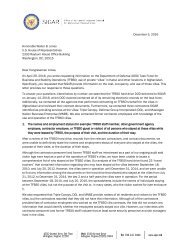SIGAR
2016-04-30qr
2016-04-30qr
Create successful ePaper yourself
Turn your PDF publications into a flip-book with our unique Google optimized e-Paper software.
<strong>SIGAR</strong> oversight Activities<br />
and USAID’s Evaluation Guidelines for Foreign Assistance calls for program<br />
evaluations, which focus on a program area in a country and cover<br />
multiple activities, to give a total understanding of U.S. government programs<br />
in a thematic area, such as education. State did not evaluate progress<br />
at this level. Instead, based on documentation provided by State, <strong>SIGAR</strong><br />
determined that State evaluated the progress of its individual programs—as<br />
required by U.S. Embassy Kabul guidance—but did not aggregate these<br />
evaluations into one overall assessment of its efforts.<br />
Since 2008, USAID has aggregated and assessed performance across its<br />
education programs in Afghanistan through its required portfolio reviews<br />
and annual Performance Plan and Report submissions. However, <strong>SIGAR</strong>’s<br />
analysis showed that these assessments did not reflect a complete study<br />
of overall progress in the sector. USAID officials acknowledged that they<br />
do not assess the overall performance of the education sector but noted<br />
that they do assess the performance of individual education programs to<br />
determine if they are on track to achieve their intended results, as called<br />
for in USAID guidance. Best practices and State and USAID guidance call<br />
for compiling monitoring and evaluation data from individual programs<br />
into agency-level assessments of the impact of those efforts overall. If<br />
USAID already assesses data on progress at the individual program level,<br />
the agency should already have relevant data available to help compile into<br />
an overall assessment of its progress in the education sector. Without comprehensive<br />
assessments of the work performed in education, DOD, State,<br />
and USAID will be unable to determine the impact that the approximately<br />
$759.5 million they have spent has had in improving Afghan education.<br />
To help demonstrate and report on its overall progress in the education<br />
sector, USAID uses education statistics that are not always based<br />
on USAID performance data and cannot be linked to its specific education<br />
programs. For example, in USAID’s 2014 fact sheet on education in<br />
Afghanistan, USAID cited Afghan government data showing increased<br />
student enrollment—from 900,000 students in 2002 to 8 million in 2013—as<br />
evidence of overall progress in the sector. Importantly, USAID is not able to<br />
demonstrate how its specific education programs are linked to supporting<br />
these Afghan-reported results and cannot verify whether this Afghan data<br />
is reliable. Both the Afghan Ministry of Education (MOE) and independent<br />
assessments have raised significant concern that the MOE’s education data<br />
may be inaccurate. <strong>SIGAR</strong> has previously reported on the risks associated<br />
with the U.S. government relying on unverified data provided by the<br />
Afghan government. Accurate and reliable accounting of data is necessary<br />
to ensure full accountability of U.S. funds and inform decision-making on<br />
programming and funding. Because the agency relies on Afghan education<br />
performance data that is not solely and directly attributable to specific<br />
USAID programs and is unreliable, USAID may be inaccurately portraying<br />
its program contributions to the education sector in Afghanistan.<br />
24<br />
Special inspector general I Afghanistan reconstruction




